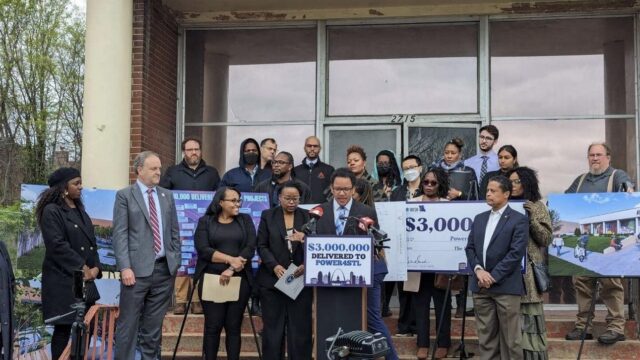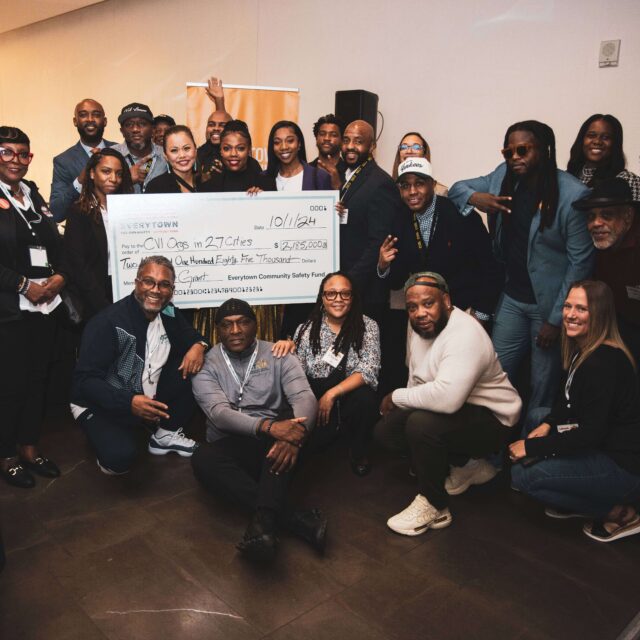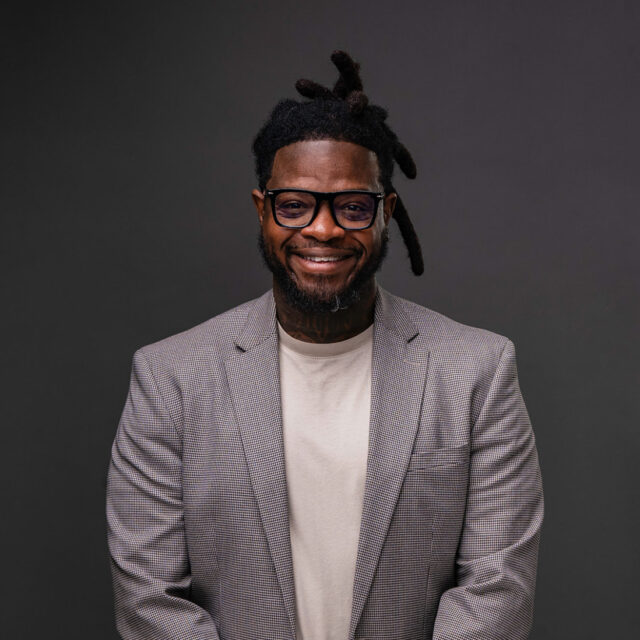What Is CVI? An In-Depth Look at Community Violence Intervention

5.29.2025
Community violence intervention (CVI) programs are critical to reducing violence. They work by applying localized, community-driven approaches, particularly in communities that are disproportionately impacted by gun violence due to systemic disinvestment and discrimination.
These programs, however, are often under-resourced and overlooked. The Everytown Community Safety Fund (CSF) is proud to have directly invested grants and capacity-building training in over 100 of these programs since 2019 and remains committed to advocating for their resourcing to create safer communities.
What Is CVI?
Community violence intervention (CVI) is a public safety strategy rooted in prevention, trust, and healing. It seeks to reduce gun violence by identifying and supporting the small group of individuals most at risk of causing harm/ experiencing harm.
CVI organizations and/or programs build personal relationships with and directly serve the people in their neighborhoods or communities. These organizations work to address the root causes of violence, including historic disinvestment in neighborhoods, social determinants of health like food and/or housing insecurity, and discriminatory policing.
CVI is a promising, evidence-informed strategy. Programs use targeted interventions that can help reduce shootings, homicides, and retaliation in cities across the U.S. These interventions are community-driven and trauma-informed. Many CVI models are adapted from public health approaches that treat violence like a disease: identifying those most at risk, intervening early, and supporting recovery and long-term health. In recent years, as CVI initiatives have expanded, the country has also experienced historic reductions in crime rates.
At its core, CVI is about putting resources into people. It’s about acknowledging that safety is more than the absence of crime; it is also the presence of opportunity, support, and connection.
Despite the vital role that CVI organizations play in reducing violence and rebuilding community trust, the organizations themselves have historically faced barriers to accessing funding. Additionally, in just the last few weeks, several important sources of federal funding for key public safety initiatives, including CVI programs, have been cut. In the wake of barriers and uncertainties, CSF grantees remain committed to doing everything in their power to serve those most at risk in their communities.
How CVI Transforms Communities
CVI has positive effects on public safety and community well-being. By engaging directly with those most likely to be involved in gun violence, CVI programs can:
- Reduce shootings and homicides
- Improve access to education, housing, and jobs
- Promote healing through trauma-informed care
- Foster trust between residents and institutions
Who Are CVI Practitioners?
CVI practitioners are frontline professionals working to interrupt cycles of violence in real time. They often come from the same neighborhoods they serve and have lived experiences that allow them to connect deeply with those at risk. Their roles vary, but commonly include:
-
Violence Interrupters
Individuals who intervene in brewing conflicts to prevent retaliation or escalation.
-
Outreach workers
Trusted community members who build relationships with people at high risk and connect them to resources like housing, education, or employment.
-
Peer mentors
Often formerly incarcerated or system-impacted individuals who guide others toward safer life paths.
-
Case managers
Professionals who assist clients with setting goals, accessing services, and navigating trauma recovery.
-
Faith and community leaders
Respected figures who advocate for peace, facilitate healing spaces, and build community trust.
What unites all CVI practitioners is their deep commitment to the well-being of their communities. They don’t just respond to violence—they work to prevent it through connection, compassion, and accountability.
FORCE Detroit—Detroit, Michigan

FORCE Detroit mobilizes faith leaders, youth organizers, and returning citizens to act as credible messengers and conflict mediators. They intervene in moments of high tension, often diffusing potentially deadly situations before they escalate.
“Our work is, quite literally, saving lives—and I know that from personal experience, because it saved mine.”
—DuJuan “Zoe” Kennedy, FORCE Detroit
The Bullet Related Injury Clinic (BRIC)—St. Louis, Missouri

The BRIC uses a hospital-based violence intervention model to heal trauma in St. Louis by bridging the fatal gaps in care that occur for people who have been threatened and injured by bullets, as well as those who have injured others with bullets.
“I am inspired daily to continue in this work by the incredible team I work with, the patients and families who trust us every day to be part of their healing journey, and the vast community of social and health care providers who themselves suffer from bullet-related injuries and need to know a different way is possible. Bullet-related injury is a whole-person injury, and it requires whole-person care.”
—Dr. LJ Punch, trauma surgeon and executive director and founder of The BRIC
Types of CVI Programs
CVI is not one-size-fits-all. Programs are designed based on the specific needs of the community, and may include:
-
Hospital-Based Violence Intervention Programs (HVIPs)
These programs engage survivors of gun violence during their hospital stay—often a critical moment for change. Staff provide trauma support and long-term follow-up to prevent retaliation or repeat injury.
→ Example: Youth ALIVE! in Oakland offers bedside interventions and connects survivors to therapy, housing, and legal support.
-
Street Outreach
Trained outreach workers patrol neighborhoods to build relationships, mediate conflicts, and connect people to services that reduce their risk of violence.
→ Example: Advocates 4 Peace and Urban Unity in Missouri maintains a constant presence in high-risk areas, using conflict mediation and trauma recovery efforts to prevent shootings before they occur.
-
Trauma Recovery and Healing Services
Many CVI programs include mental health support for survivors, families, and frontline staff. Services may include grief counseling, group therapy, and community healing circles.
→ Example: Living Classrooms Foundation in Baltimore integrates mental health support, education, and community engagement.
-
Youth Development and Mentorship
Programs that work with young people offer life skills, education support, and mentorship to create pathways away from violence and incarceration.
→ Example: The TraRon Center in Washington, D.C., provides a safe, supportive space for young survivors to explore their pain and purpose through arts-based therapy and mentorship.
Barriers to CVI’s Success
Despite its effectiveness, CVI programs face significant obstacles that threaten their sustainability and impact.
1. Limited Resourcing
Some municipal and state governments and law enforcement agencies are slow to embrace CVI as a credible addition to public safety apparatuses. This hesitance can limit collaboration, access to resources, and public awareness.
Further intensifying the strain on the field, in April 2025, the U.S. Department of Justice made steep cuts to the Community Violence Intervention and Prevention Initiative (CVIPI)—a federal program providing critical funding to CVI organizations nationwide. These cuts came despite strong evidence that CVI saves lives and builds safer neighborhoods.
Without stable funding, many organizations are being forced to scale back services or shut down altogether, leaving communities more vulnerable to violence.
2. Burnout Among Practitioners
CVI work is emotionally and physically demanding. Practitioners often witness trauma and loss firsthand, and without sufficient mental health support or compensation, they risk burnout and secondary trauma.
Common Misconceptions About CVI
Despite its growing recognition, CVI is still misunderstood. Here are a few common myths:
- “CVI is soft on crime.”
→ Reality: CVI directly engages those most likely to commit or experience violence, preventing harm before it occurs. - “It only works in big cities.”
→ Reality: CVI is being used in rural areas, small towns, and suburbs. Violence is not just an urban issue. - “CVI replaces the police.”
→ Reality: CVI offers an additional layer of community-based safety. It complements emergency response systems but is grounded in prevention and healing. - “CVI isn’t research-based.”
→ Reality: Research is expanding rapidly as CVI programs are proliferating—and findings from the research to date are promising.
About the Everytown Community Safety Fund
The Everytown Community Safety Fund, a program of the Everytown for Gun Safety Support Fund, provides financial support to grassroots CVI organizations across the country. It prioritizes supporting the people and programs at the forefront of redefining public safety, including:
- Organizations led by Black and Brown leaders
- Programs deeply rooted in the communities they serve
- Efforts that emphasize healing, equity, and long-term safety
Whether offering trauma-informed care, interrupting violence on the streets, or mentoring youth, they are the architects of a new safety infrastructure.
Final Thoughts
CVI is not just a public safety strategy—it’s a human-centered ecosystem. Supporting CVI means supporting peace, and peace begins with people. CVI reimagines safety through empathy, proximity, and purpose. And its practitioners and programs inform what drives the daily work and mission of the Everytown Community Safety Fund: By investing in the people most affected by violence, we create safer, stronger, and more connected communities.





